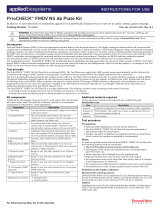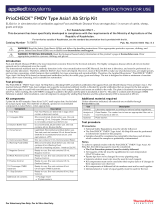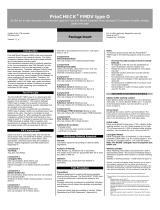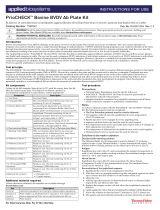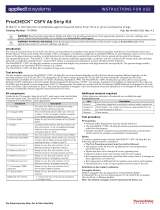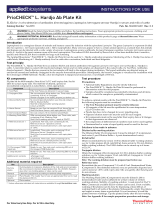Page is loading ...

For Veterinary Use Only. For In Vitro Use Only.
INSTRUCTIONS FOR USE
PrioCHECK™ FMDV NS Ab Plate Kit
ELISA for
in vitro
detection of antibodies against non-structural protein of Foot and Mouth Disease Virus in serum of cattle,
sheep, goats and pigs
Catalog Number 7610760
Pub. No. MAN0013923 Rev. B.0
WARNING!
Read the Safety Data Sheets (SDSs) and follow the handling instructions. Wear appropriate protective eyewear, clothing, and
gloves. Safety Data Sheets (SDSs) are available from thermofisher.com/support.
WARNING! POTENTIAL BIOHAZARD.
Read the biological hazard safety information at this product’s page at thermofisher.com. Wear
appropriate protective eyewear, clothing, and gloves.
Introduction
Foot and Mouth Disease (FMD) is the most important economic threat to the livestock industry. The highly contagious disease affects all cloven-hoofed
animals and is widespread over the world. The FMD viruses are classified into 7 distinct serotypes which makes diagnosis using conventional serological
methods complex. To control outbreaks in the future emergency vaccination will be carried out. Vaccines consist of (partly) purified structural proteins of
the FMD virus and therefore vaccinated animals only elicit antibodies directed against the structural proteins of the virus. However, after infection with
FMDV, antibodies directed against the structural and the non-structural proteins are produced. Therefore an ELISA detecting antibodies against non-
structural proteins of FMDV detects not only infected animals but also discriminates between infected and vaccinated animals.
The Applied Biosystems™ PrioCHECK™ FMDV NS Ab Plate Kit detects antibodies directed against the non-structural 3ABC protein of FMDV. The ELISA
detects FMDV infected animals independent of the serotype that causes the infection and independent of the fact that the animal is vaccinated or not. The
ELISA can be used to test serum samples of cattle, sheep, goats and pigs [1].
Test principle
The PrioCHECK™ FMDV NS Ab Plate Kit is a blocking ELISA. The Test Plates are coated with 3ABC specific monoclonal antibody (mAb), followed by
incubation with antigen (3ABC protein). Consequently, Test Plates of the kit contain FMDV NS antigen captured by the coated mAb.
The test is performed by dispensing the test samples to the wells of a Test Plate. After incubation the plate is washed and the Conjugate is added. FMDV NS
specific antibodies, directed against the non-structural proteins, that may be present in the test sample will bind to the 3ABC protein and will block the
binding of the mAb-HRPO. After incubation, the plate is washed and the Chromogen (TMB) Substrate is dispensed. After incubation at room temperature
(22±3°C) the color development is stopped. Color development measured optically at a wavelength of 450 nm shows the presence of antibodies directed
against Foot and Mouth Disease Virus.
The PrioCHECK™ FMDV NS Ab Plate Kit is a single dilution test. The dilution of serum varies according to the protocol selected.
• Overnight serum incubation protocol: Serum samples are tested in a 1:5 dilution.
• Single-day serum incubation protocol: Serum samples are tested in a 1:2.6 dilution.
Kit components
10 plate kit for 900 samples. Store kit at 5±3°C until expiry date. See kit label
for actual expiry date. The shelf life of diluted, opened or reconstituted
components is noted below, when appropriate.
Component
Description
1: Test Plate
Ten Test Plates are delivered in bags which contain
a desiccant sachet.
2: Conjugate (30x)
30x concentrated, dilute before use. Two vials, each
contains 2.2 mL Conjugate. Diluted conjugate is not
stable, prepare just before use.
3: Dilution Buffer (2x)
2x concentrated, dilute before use. Two vials, each
contains 60 mL Dilution Buffer. Shelf life of the
dilution buffer working solution: 24 hours at 5±3°C.
4: Additive
Lyophilized. Reconstitute and dilute before use. Five
vials, each contains 5.0 mL lyophilized Additive. Shelf
life of reconstituted additive: until expiry date at −20°C.
5: Demineralized
Water
Three vials, each contains 10 mL Demineralized
Water.
6: Washing Fluid
(200x)
200x concentrated, dilute before use. One vial
contains 60 mL Washing Fluid. Shelf life of washing
solution: 1 week at 22±3°C.
7: Positive Control
Ready-to-use. One vial contains 1.4 mL Positive
Control.
8: Weak Positive
Control
Ready-to-use. One vial contains 1.4 mL Weak
Positive Control.
9: Negative Control
Ready-to-use. One vial contains 1.4 mL Negative
Control.
10: Chromogen (TMB)
Substrate
Ready-to-use. Two vials, each contains 60 mL
Chromogen (TMB) Substrate.
11: Stop Solution
Ready-to-use. Two vials, each contains 60 mL Stop
Solution.
Additional kit
contents:
• Package Insert
• 20 plate sealers
Additional material required
Unless otherwise indicated, all materials are available through
thermofisher.com.
Use
Description
General
Laboratory equipment according to national safety regulations.
Analysis of
results
Plate Reader. The reader has to have an appropriate filter set
to read the plates at 450 nm.
Optional
Plate washer.
Test procedure
Precautions
• National Safety Regulations must be strictly followed.
• The PrioCHECK™ FMDV NS Ab Plate Kit must be performed in
laboratories suited for this purpose.
• Samples should be considered as potentially infectious and all items
which contact the samples as potentially contaminated.
Notes
To achieve optimal results with the PrioCHECK™ FMDV NS Ab Plate Kit,
the following aspects must be considered:
• The Test Procedure protocol must be strictly followed.
• All reagents of the kit must be equilibrated to room temperature
(22±3°C) before use.
• Pipette tips have to be changed for every pipetting step.
• Separate solution reservoirs must be used for each reagent.
• Kit components must not be used after their expiry date or if changes in
their appearance are observed.
• Kit components of different kit lot numbers must not be used together.
• Demineralized or water of equal quality must be used for the test.
Solutions to be made in advance
Dilution buffer working solution
Dilute Dilution Buffer (2x) (Component 3) 1:2 in demineralized water; e.g.
for one Test Plate prepare 24 mL (add 12 mL Dilution Buffer (2x) to 12 mL
demineralized water). Can be stored at 5±3°C for up to 24 hours.
Additive
Equilibrate the vial to 22±3°C and reconstitute the Additive (Component 4)
with 5.0 mL Demineralized Water (Component 5). Can be stored at −20°C
until expiry date.

thermofisher.com/support | thermofisher.com/askaquestion
thermofisher.com
20 June 2022
Reconstitution of the lyophilized Additive should be performed as follows:
1. Equilibrate the vial to 22±3°C.
2. With the vial in an upright position, tap the vial gently against the
worktop to ensure that the content is on the bottom of the vial.
3. Carefully open the vial.
4. Add the specified amount of Demineralized Water (Component 5).
5. Replace the stopper on the vial and allow the lyophilized material to
dissolve.
6. Gently agitate the vial so that any remaining dry material will be
dissolved.
7. Allow the material to stand at least for 15 minutes at 22±3°C before use.
8. Mix gently and intermittently (formation of foam should be avoided).
ELISA buffer
Dilute reconstituted additive 1:10 in dilution buffer working solution; e.g.
for one Test Plate prepare 24 mL (add 2.4 mL reconstituted additive to
21.6 mL dilution buffer working solution). Unused ELISA buffer can be
stored at 5±3°C for up to 24 hours.
Conjugate dilution
Dilute Conjugate (30x) (Component 2) 1:30 in ELISA buffer; e.g. for one
plate prepare 12 mL (add 400 µL Conjugate (30x) to 11.6 mL ELISA buffer).
Note: The diluted conjugate must be prepared just before use.
Washing solution
Dilute Washing Fluid (200x) (Component 6) 1:200 in demineralized water.
The amount of Washing Fluid is sufficient to prepare a final volume of
12 liters washing solution.
Stability of washing solution: 1 week stored at 22±3°C.
Remark: Commercial available ELISA washers can be used. If not available,
washing of the plates can be done by dispensing at least 200 µL of washing
solution to all wells of the plate. Subsequently, empty the plate and repeat
as many times as prescribed. It is not necessary to soak the plate between
washings. Tap the plate firmly after the last washing step.
Incubation with test serum
Perform the serum incubation using the overnight or single-day protocol.
The required volumes of the test and control samples differ, depending on
the protocol selected.
Overnight serum incubation protocol
1. Dispense 80 µL ELISA buffer to all wells of the Test Plate
(Component 1).
2. Dispense 20 µL of Negative Control (Component 9) to wells A1 and B1.
3. Dispense 20 µL of Weak Positive Control (Component 8) to wells
C1 and D1.
4. Dispense 20 µL of Positive Control (Component 7) to wells E1 and F1.
5. Dispense 20 µL of test samples to the remaining wells.
6. Seal the Test Plate using the enclosed plate sealers.
7. Shake the Test Plate gently.
8. Incubate overnight (16–18 hours) at 22±3°C.
Single-day serum incubation protocol
1. Dispense 80 µL ELISA buffer to all wells of the Test Plate (Component 1).
2. Dispense 50 µL of Negative Control (Component 9) to wells A1 and B1.
3. Dispense 50 µL of Weak Positive Control (Component 8) to wells
C1 and D1.
4. Dispense 50 µL of Positive Control (Component 7) to wells E1 and F1.
5. Dispense 50 µL of test samples to the remaining wells.
6. Seal the Test Plate using the enclosed plate sealers.
7. Shake the Test Plate gently.
8. Incubate for 2 hours at 22±3°C.
Incubation with conjugate
Note: This procedure is performed on day two if the overnight serum
incubation protocol is used.
1. Empty the Test Plate after the serum incubation period, then wash the
plate 6 times with 200 to 300 µL of washing solution. Tap the plate
firmly after the last washing step.
2. Dispense 100 µL of diluted conjugate to all wells.
3. Seal the Test Plate using the enclosed plate sealers.
4. Incubate 60±5 minutes at 22±3°C.
Incubation with Chromogen (TMB) Substrate
1. Empty the Test Plate after the incubation period and wash the plate 6
times with 200 to 300 µL washing solution. Tap the plate firmly after
the last washing step.
2. Dispense 100 µL of Chromogen (TMB) Substrate (Component 10) to all
wells.
3. Incubate 20 minutes at 22±3°C.
4. Add 100 µL of Stop Solution (Component 11) to all wells.
5. Mix the content of the wells of the Test Plate prior to measuring.
Note: Start the addition of Stop Solution 20 minutes after the first well was
filled with Chromogen (TMB) Substrate. Add the Stop Solution in the same
order and at the same pace as the Chromogen (TMB) Substrate was
dispensed.
Reading of the test and calculating the results
1. Measure the optical density (OD) of the wells at 450 nm within
15 minutes after color development has been stopped.
2. Calculate the mean OD450 value of wells A1 and B1 (Negative Control
= OD450 max).
3. The percentage inhibition (PI) of the Controls and the test sera are
calculated according to the formula below.
The OD450 values of all samples are expressed as Percentage Inhibition (PI)
relative to the OD450 max.
PI = 100 − (OD450 test sample / OD450 max) × 100
Result interpretation
Validation criteria
1. The OD450 max (mean OD450 of the Negative Control) must be >1.000.
2. The mean percentage inhibition of the Weak Positive Control must
be >50%.
3. The mean percentage inhibition of the Positive Control must be >70%.
Not meeting any of these criteria is reason to discard the results of that
specific Test Plate.
Note: If the OD450 of a test sample is higher than the OD450 max, the Percent
Inhibition can be interpreted as 0%. If the mean OD450 of the Negative
Control is below 1.000 possibly the Chromogen (TMB) Substrate is too cold.
In that case warm the solution to 22±3°C or incubate up to 30 minutes.
Interpretation of the percent inhibition
PI = <50% Negative
Antibodies against the NS protein of FMDV are
absent in the test sample.
PI = ≥50% Positive
Antibodies against the NS protein of FMDV are
present in the test sample.
Appendix - References
Sørensen KJ, Madsen KG, Madsen ES, Salt JS, Nqindi J, Mackay DKJ (1998)
Differentiation of infection from vaccination in foot-and-mouth disease by
the detection of antibodies to the non-structural proteins 3D, 3AB and
3ABC in ELISA using antigens expressed in baculovirus. Arch Virol
143:1461–1476.
Customer and technical support
Technical support: visit thermofisher.com/askaquestion
Visit thermofisher.com/support for the latest in services and support,
including:
• Worldwide contact telephone numbers
• Order and web support
• User guides, manuals, and protocols
• Certificates of Analysis
• Safety Data Sheets (SDSs; also known as MSDSs)
NOTE: For SDSs for reagents and chemicals from other manufacturers,
contact the manufacturer.
Limited product warranty
Life Technologies Corporation and/or its affiliate(s) warrant their products
as set forth in the Life Technologies' General Terms and Conditions of Sale
found on Life Technologies' website at www.thermofisher.com
/us/en/home/global/terms-and-conditions.html. If you have any questions,
please contact Life Technologies at thermofisher.com/support.
Prionics Lelystad B.V. | Platinastraat 33 | 8211 AR Lelystad | The Netherlands
The information in this guide is subject to change without notice.
DISCLAIMER: TO THE EXTENT ALLOWED BY LAW, LIFE TECHNOLOGIES AND/OR ITS AFFILIATE(S)
WILL NOT BE LIABLE FOR SPECIAL, INCIDENTAL, INDIRECT, PUNITIVE, MULTIPLE, OR
CONSEQUENTIAL DAMAGES IN CONNECTION WITH OR ARISING FROM THIS DOCUMENT,
INCLUDING YOUR USE OF IT.
Revision history of Pub. No. MAN0013923 (English)
Rev.
Date
Description
B.0 20 June 2022
Removed recommendation for a shorter incubation period with the
Chromogen (TMB) Substrate if the mean
OD450 of the Negative Control is
above 2.000.
A.0 15 July 2019
• Converted the legacy document (PrioCHECK FMDV-NS 10 solid
7610760_v1.0_e.doc) to the current document template, with
associated updates to the publication number, limited license
information, warranty, trademarks, and logos.
• Added a single-day serum incubation protocol.
• Increased the volume of controls supplied with the kit from 0.6 mL to
1.4 mL.
• Changed the product name from PrioCHECK® FMDV NS to
PrioCHECK
™
FMDV NS Ab Plate Kit.
Important Licensing Information: These products may be covered by one or more Limited Use Label
Licenses. By use of these products, you accept the terms and conditions of all applicable Limited Use
Label Licenses.
©2022 Thermo Fisher Scientific Inc. All rights reserved. All trademarks are the property of Thermo
Fisher Scientific and its subsidiaries unless otherwise specified.
/
